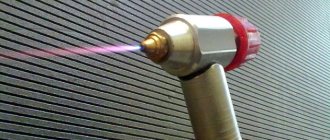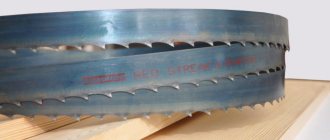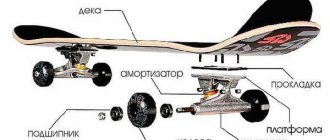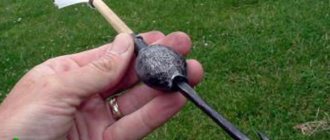An electromagnet is a special type of magnet in which a magnetic field is created by applying an electric current to that magnet. In the absence of current, the magnetic field disappears, and this feature is useful in many areas of electrical engineering.
An electromagnet is a fairly simple device, so its manufacture is quite simple and inexpensive. Even some schools show students the basic technique of making electromagnets using a wire, a nail and a battery.
And students watch in amazement as the quickly built electromagnet lifts lightweight metal objects such as paper clips, pins and nails.
But you can also make your own powerful DC electromagnet that is several times stronger than the ones they make in classrooms.
So, first, place your fingers on the wire 50 centimeters from the end. Wrap the wire around the top of the steel pin (you can use a large nail), starting from where your fingers rest on the wire. Carry out the winding smoothly and carefully until the very end of the pin.
Once you reach the end, begin wrapping the wire over the first layer, making a new wrap towards the top of the pin. Then wrap the wire back over the pin towards the bottom, making a second layer.
Cut the wire from the coil, leaving a 50cm piece of wire at the bottom of the pin.
Next, connect the top copper wire to the negative terminal and the bottom copper wire to the positive terminal of the battery. Make sure the wires make good contact with the terminals.
It is advisable to have a button to turn on the battery, or you can put a contactor on one end of the wire to supply power to the electromagnet, completing the circuit when needed.
After successful assembly, check the functionality of the electromagnet by bringing various metal objects to it.
It should be noted that the more powerful the battery you use, the more powerful your electromagnet will be.
Increasing the battery voltage and using more layers of the electromagnetic coil increases the power of the electromagnet.
But at the same time, you need to monitor the condition of the wire, since it can become very hot, which can ultimately be dangerous. If the thickness of the wire is small, then such wire will generate more heat.
© digitrode.ru
Source: https://digitrode.ru/articles/1138-kak-sdelat-moschnyy-elektromagnit-postoyannogo-toka-svoimi-rukami.html
How to make an electromagnet at home
An electromagnet is an artificial magnet in which a magnetic field arises and is concentrated in a ferromagnetic core as a result of the passage of electric current through the winding surrounding it, i.e. When current is passed through the coil, the core placed inside it acquires the properties of a natural magnet.
The scope of application of electromagnets is very wide. They are used in electrical machines and devices, in automation devices, in medicine, and in various types of scientific research. Most often, electromagnets and solenoids are used to move some mechanisms, and in industries to lift loads.
For example, a lifting electromagnet is a very convenient, productive and economical mechanism: no maintenance personnel are required to secure and release the transported cargo.
It is enough to place an electromagnet on the moving load and turn on the electric current in the electromagnet coil and the load will be attracted to the electromagnet, and to release the load you only need to turn off the current.
The design of an electromagnet is easy to replicate and is essentially nothing more than a core and a coil of conductor. In this article we will answer the question of how to make an electromagnet with your own hands?
How an electromagnet works (theory)
If an electric current flows through a conductor, a magnetic field is formed around this conductor. Since current can only flow when the circuit is closed, the conductor must be a closed loop, such as a circle, which is the simplest closed loop.
Previously, a conductor rolled into a circle was often used to observe the effect of current on a magnetic needle placed in its center. In this case, the arrow is at an equal distance from all parts of the conductor, making it easier to observe the effect of the current on the magnet.
To increase the effect of electric current on a magnet, you can first increase the current. However, if you bend a conductor through which some current flows twice around the circuit it covers, then the effect of the current on the magnet will double.
In this way, this action can be increased many times over by bending the conductor an appropriate number of times around a given circuit. The resulting conducting body, consisting of individual turns, the number of which can be arbitrary, is called a coil.
Let's remember the school physics course, namely that when an electric current flows through a conductor, a magnetic field arises. If the conductor is rolled into a coil, the magnetic induction lines of all turns will add up, and the resulting magnetic field will be stronger than for a single conductor.
- The magnetic field generated by electric current, in principle, has no significant differences compared to the magnetic field. If we return to electromagnets, the formula for its traction force looks like this:
- F=40550∙B2∙S,
- where F is the traction force, kg (force is also measured in newtons, 1 kg = 9.81 N, or 1 N = 0.102 kg); B – induction, T; S – cross-sectional area of the electromagnet, m2.
- That is, the traction force of an electromagnet depends on the magnetic induction, consider its formula:
Here U0 is the magnetic constant (12.5*107 H/m), U is the magnetic permeability of the medium, N/L is the number of turns per unit length of the solenoid, I is the current strength.
It follows that the force with which a magnet attracts something depends on the current strength, the number of turns and the magnetic permeability of the medium. If there is no core in the coil, the medium is air.
Below is a table of relative magnetic permeabilities for different media. We see that for air it is equal to 1, and for other materials it is tens and even hundreds of times greater.
In electrical engineering, a special metal is used for cores; it is often called electrical or transformer steel. In the third line of the table you see “Iron with silicon” whose relative magnetic permeability is 7 * 103 or 7000 H/m.
This is the average value for transformer steel. It differs from the usual one precisely in the silicon content. In practice, its relative magnetic permeability depends on the applied field, but we will not go into details. What does the core do in the coil? An electrical steel core will enhance the magnetic field of the coil by approximately 7000-7500 times!
General information about the design
The main advantage of magnetic plates is their good workpiece fixation rate, as well as their relatively small size. To complete the machines, two types are used: electromagnetic and magnetic. They have significant design differences.
The stove has a fairly simple operating principle. A magnetic field is created on its surface, which holds metal-containing workpieces on the table surface. This allows you to process not only the outer plane of the materials, but also the end areas. In some cases, it is possible to grind several parts at the same time. Thanks to its magnetic properties, additional equipment or auxiliary devices can be installed on the work surface.
Design features of various types of magnetic plates:
- electromagnetic plate. It consists of a housing, inside of which there are two groups of electromagnetic coils. They are separated by a non-magnetic layer. When electricity is supplied to the installed part, an electromagnetic field is formed, which fixes the workpiece. The disadvantage of this design is the lack of clutch in the event of a power outage. Therefore, it is recommended to install a machine deactivation relay when such a situation occurs;
- magnetic plate. Structurally, it resembles an electromagnetic model. It also contains two groups of magnets that differ in polarity. Blocks of non-magnetic material are installed on the working surface of the stove. In their normal position, they prevent the emergence of a magnetic field. With the help of a mechanical device, they are shifted, as a result of which the workpiece is securely fixed on the table.
The mechanical magnetic plate has a high degree of reliability, but to turn it on/off you need to turn the lever. This affects the speed of changing the positions of parts, and as a result, productivity. Therefore, electromagnetic models are most often used for mass production, and mechanical ones for more precise processing.
In addition to horizontally oriented grinding plates, a device for cross-drilling rollers can be used. Magnets are located along the workpiece, which makes it possible to process cylindrical parts of complex shapes.
how to make a 12 volt electromagnet
How to make a powerful electromagnet???? retractor electromagnet...
How to make an electromagnet with your own hands at home - instructions
12 volt electromagnet
Electromagnet how to calculate. — Thoughts and ideas — Metal Forum
How to make a powerful electromagnet
How to make a powerful electromagnet???? retractor electromagnet...
Homemade powerful electromagnet - YouTube
How to Make a Powerful 6-12V Electromagnet - For Beginners - Forum on...
Electromagnet from a relay, 12V - Educational and funny videos
Electromagnet 12 volt. How to make a simple electromagnet...
Electromagnet in half an hour - YouTube
DIY electromagnet - YouTube
How to make a powerful electromagnet
Back to the question of a homemade choke solenoid... - Forum...
3 DIY electromagnet (homemade electromagnet) - YouTube
Tips on how to make an electromagnet with your own hands
DIY electromagnet: theory and practice
How to make a powerful electromagnet
A simple but powerful ELECTROMAGNET with your own hands 12 volts 1.8 (Almost 2 ...
Tips on how to make an electromagnet with your own hands
ED-11101 Electromagnet 127 Volt buy in Moscow for RUB 12,418...
ED-11101 Electromagnet 24 Volt buy in Moscow for RUB 12,418...
Calculation and Manufacturing of an Electromagnet - For Beginners - Forum on...
Buy SOLENOID at the COSMODROME warehouse, Kharkov, Ukraine
DIY electromagnet: theory and practice
Micro Electromagnet 30a 12 Volt DC Relay Sli 12vdc Sl...
Super electromagnet - YouTube
How to Make a Powerful 6-12V Electromagnet - For Beginners - Forum on...
Electromagnet EM-33-6, 220 volts,
DIY electromagnet: theory and practice
DIY electromagnet: theory and practice
Buy electromagnet 12V 1A 30x15x14mm
How to make an electromagnet with your own hands at home - instructions
Homemade demagnetizer or how to demagnetize a tool
12 volt electromagnet - Sandbox (Qu0026A) - Radio electronics forum
How to make a powerful electromagnet with your own hands! -YouTube
Rewind the electromagnet to a different voltage. u2014 Forum about radio
How to make a powerful electromagnet???? retractor electromagnet...
Electronics Developers Forum ELECTRONIX.ru u003e Electromagnetic lock
How to make an electromagnet with your own hands at home - instructions
Method 5. License plates without a reflective layer
The license plate is covered with reflective material. If you order duplicates of your own signs for 6,000–7,000 rubles without this coating, then at night you can save on fines in places where the illumination of the section of the road near the camera is insufficient. This trick won’t work with a rear license plate - it will show the mandatory number plate illumination. And a traffic police officer, having stopped your car on the road and seeing that the license plates do not reflect the light, recognizes them as modified - and hello, the already familiar Article 12.2 part 2 of the Code of Administrative Offenses of the Russian Federation.
Conclusion: the method is partially effective, but you can lose your rights.
How to make an electromagnet - World of Magnets blog
An electromagnet, unlike a permanent magnet, acquires its properties only under the influence of electric current. With its help, he changes the force of attraction, the direction of the poles and some other characteristics.
Some people who are passionate about mechanics make their own electromagnets to use them in homemade installations, mechanisms and various designs. Making an electromagnet with your own hands is not difficult.
Simple devices and available materials are used.
The simplest kit for making an electromagnet
What you will need:
- One iron nail 13-15 cm long or another metal object, which will become the core of the electromagnet.
- About 3 meters of insulated copper wire.
- The power source is a battery or a generator.
- Small wires for connecting the wire to the battery.
- Insulating materials.
If you are using a larger piece of metal to create a magnet, the amount of copper wire must be increased proportionally. Otherwise, the magnetic field will be too weak. It is impossible to answer exactly how many windings will be needed. Usually craftsmen find out this experimentally, increasing and decreasing the amount of wire, while simultaneously measuring changes in the magnetic field. Due to the excess wire, the strength of the magnetic field also becomes weaker.
Technical specifications
Magnetic plates are rarely included as standard equipment in factory equipment. Most often they are purchased separately. Therefore, it is important to know their main technical characteristics, which must correspond to the parameters of a specific machine model.
The determining parameter is the dimensions. The size of the plate can vary from 10*25 cm to 32*100 cm. Moreover, as the dimensions of the device increase, its weight increases. This directly affects the maximum weight of the workpiece, since the plate is installed on a standard work table.
The main parameters that a magnetic plate should have:
- dimensions and weight. Not only width and length are taken into account, but also height. It may affect the maximum permissible part size;
- specific force of attraction. It must be uniform over the entire installation plane. Typically this parameter ranges from 50 to 120 N/cm²;
- distance between poles. This characteristic determines the minimum size of the workpiece.
During operation, the magnetic plate can change the geometry of the workpiece. Therefore, the process of installing and subsequently removing the part should be as careful as possible. You should also take into account the main disadvantage of electromagnetic models - heating of the surface during activation. This is not only the main reason for device failure, but also affects the properties of the workpiece.
The video shows an example of how a small magnetic plate works:
Peculiarities
To prevent exposure to environmental conditions, the magnets are coated with a protective compound. Typically these are two layers of nickel or an improved version with an additional layer of copper in between. Another important feature is that neodymium magnets begin to demagnetize at temperatures above 70 °C. Exceeding the limit values can lead to a complete loss of properties and the alloy turning into just a piece of metal.
The specifics of the material require special safety measures during operation. Thus, neodymium magnets 50x30 mm have an adhesion force of 100 - 115 kg, and 70x50 mm up to 300 kg
If handled carelessly, they can cause harm: pinching fingers, injuring the skin, damaging bones. In the event of an uncontrolled collision of two magnets, the material may crumble with the formation of sharp fragments that can injure the eyes
FAQ
Is it legal to buy a magnet in itself?
In the Russian Federation, it is prohibited to purchase items withdrawn from civilian circulation: drugs, weapons, extremist literature. A magnet is not one of them, so purchasing it is not a violation.
GOST does not directly prohibit installation. Is it possible to avoid responsibility?
In theory, yes. However, appealing the protocol to the traffic police will most likely yield nothing. You will have to file a complaint in court and hire a good lawyer. This will require significant costs. It’s easier to pay a five-hundred-ruble fine and continue driving with the magnet.
Aliexpress car license plate magnet
Car license plate magnet - hides license plates from CCTV cameras. Let's consider the principle of operation, where to buy, price and characteristics. At the end of the article there is a video review of the magnet for the number.
A car license plate magnet is one of the latest developments for hiding license plate numbers from surveillance cameras. The magnet works on the principle of supplying power from the vehicle's on-board network, and is controlled using a small remote control. At first glance, it seems that the number has been touched by a foreign object, a leaf from a tree or a small piece of paper, kissed. In this case, surveillance cameras simply will not be able to recognize the license plate number of the car.
Making a surface grinding machine with your own hands
A surface grinding machine, which you can make yourself, is a very popular piece of equipment not only in manufacturing enterprises, but also in the home workshop.
Such a device is practically indispensable in situations where it is necessary to grind and adjust metal parts.
Of course, such work can be done manually, but this will take a lot of effort and time and will not allow achieving high precision processing.
Processing a workpiece on an industrial surface grinding machine
It makes sense to think about equipping your home workshop with a surface grinding machine if you often have to work on metal.
In this case, you can choose one of two options: buy serial equipment or make such a machine yourself.
The purchase of a serial machine is associated with serious financial costs, which is not always advisable for its use in a home workshop.
A homemade surface grinding machine will cost much less. Of course, the functionality of such equipment will be somewhat lower than that of serial equipment, but its capabilities will be quite sufficient to perform metal work at home.
How do surface grinding machines work?
The vast majority of parts made of metal undergo a technological operation such as grinding. To perform this with high efficiency and accuracy, surface grinding machines are used.
A rather difficult to manufacture banding machine with excellent functionality
General view of the machine Design of the work table drive
Surface grinding machines of serial models can process both flat and profile parts. The surface processing accuracy that can be achieved using such devices is 0.16 microns.
Of course, it is almost impossible to achieve such a result when processing on machines made by yourself.
However, even the accuracy that homemade machines allow to obtain is quite sufficient for many metal products.
The load-bearing structural element of the machines of this group (as well as any other equipment) is the bed. Its dimensions directly determine what size parts can be processed on the machine.
The most common material for manufacturing beds of surface grinding equipment is cast iron, since this metal, due to its characteristics, perfectly dampens vibrations, which is especially important for devices of this type.
Work table and controls of the 3G71M grinding machine
The structural element of surface grinding machines on which the workpiece is fixed is a work table having a round or rectangular shape.
Its dimensions can vary significantly depending on the specific model of surface grinding equipment. The workpieces can be fixed on such a work table due to its magnetized surface or using special clamping elements.
During processing, the work table makes reciprocating and circular movements.
In mass-produced surface grinding machines, the work tables are driven by a hydraulic system. In self-assembled equipment, mechanical transmissions are used for this.
Grinding a steel workpiece fixed on the working surface of the machine using a magnetic field
Important elements of the design of surface grinding equipment, which ensure the accuracy and smooth movement of the work table, are guides. In addition to high precision manufacturing, the guides must have exceptional strength, since in the process of almost constant movements of the desktop they are subject to active wear.
To achieve high processing accuracy, the guides must ensure accurate, smooth (without jerking) movement of the worktable with minimal friction of the contacting elements. That is why high-strength steel is used for the manufacture of these structural elements, which is hardened after the guides are made from it.
Option for manufacturing guides using angles and bearings
The working tool of a surface grinding machine, which can be a grinding wheel or an abrasive belt, is mounted on the spindle of the headstock. Rotation of the working tool, for which the main electric motor is responsible, can be transmitted through a gearbox or belt drive.
For do-it-yourself surface grinding machines, you can choose a simpler option: select the diameter of the grinding wheel so that it can be mounted directly on the electric motor shaft. This will eliminate the need to use a gear or belt drive.
Recommendations for making a surface grinding machine with your own hands
Serial surface grinding machines, in addition to their high cost, are also distinguished by their large dimensions. Not every workshop can accommodate such a machine, which also limits their use at home. That is why many craftsmen prefer equipment made by themselves.
Many structural elements for making a surface grinding machine can be found in your workshop or garage, but some of them will still have to be purchased additionally. These are materials and devices such as:
- metal corners of two types - 50x50x5 and 25x20x1.5 (their total number will depend on the size of the machine you are going to make);
- pipes with a wall thickness of 2 mm or more, made of stainless steel;
- main electric motor, the shaft rotation speed of which is 1400–1500 rpm;
- a magnetic plate, the dimensions of which will also depend on the dimensions of the parts that you are going to process;
- 4 bearings and a set of ball screws;
- rail type guides;
- grinding wheel;
- end supports in the amount of 2 pcs.
Working surface of the machine with a homemade clamping device
General view of a homemade device Design of lifting the working surface
Do-it-yourself manufacturing of a surface grinding machine begins with a frame, the frame of which is assembled from corners, cut to the required sizes and connected by welding. To increase the ability of the bed to absorb vibrations that occur during operation of the machine, a sheet of chipboard can be mounted into its lower part.
The next structural piece of equipment that will need to be manufactured is the work table, which uses a 4mm sheet of steel welded to the top of the frame.
Rail guides are fixed on the surface of the finished desktop, which must be highly durable and manufactured accurately.
Such guides can be purchased ready-made or ordered from a qualified milling machine operator.
Magnetic plate for grinding machine
A carriage will move along the worktable guides, on which a magnetic plate or a special clamping device is placed. The carriage is also made by hand from corners, which are cut to the required sizes and connected by welding.
Wheels and ball screw elements are fixed to the carriage using screw connections. A screw with a handle, which will be responsible for moving the carriage, is installed in bearing supports, fixed at both edges of the desktop.
Finally, a magnetic plate or clamping device must be fixed to the carriage.
Homemade surface grinding machine with an abrasive wheel as a working part
Homemade belt type grinding machine
The electric motor, on the shaft of which the grinding wheel is fixed, will move in the vertical direction using two guides.
As the latter, you can use stainless steel pipes welded to the frame.
The vertical movement of the metal plate base on which the electric motor will be fixed is communicated using ball screw elements.
One transmission support is fixed at the top of the guide pipes, and the second at the base itself.
To ensure the rotation of the grinding wheels, you can use electric motors from old washing machines or vacuum cleaners.
After the entire structure is assembled, you need to connect power to the motor, lubricate all the guides and perform a test run of your homemade surface grinding equipment.
Such a machine, if desired and necessary, can be modernized without problems by supplementing its design with devices that expand its functionality.
Let's sum it up
A license plate magnet is a device that, due to electromagnetic radiation, helps to hide the numbers and letters of a license plate from cameras that record offenses. Its purchase is legal, but installation on a car may entail liability. The sanction for having a device on a vehicle is a fine of 500 rubles. True, it is very difficult to detect a magnet with a number. This cannot be done with the naked eye. However, a camera or hand-held radar may well detect a foreign object under the mark.
Price of a magnet for a car license plate
Most likely, it will be difficult to list all the possible ways to hide car license plates today. Some are effective, others less effective, but the main goal is the same. The magnet we induced is an innovation and in fact there are no analogues.
In the automotive market, the price of a magnet set for a car license plate can be several hundred rubles, but this is the main indicator of quality. Many will say that it is better not to save money here, since at the most inopportune moment the mechanism can fail, and the money saved will turn into a large fine. On the other hand, such a set cannot cost a lot of money either, since the device is not complicated, and therefore the costs are not large.
In retail automobile stores, the retail price of a license plate magnet is 3,990 rubles. In the online store, a set of magnets for numbers will cost 1,990 rubles. Above is an example of where you can order such a set. The ordering process itself is not complicated, and all kinds of risks are eliminated. Just fill out the form on the website, after which an operator will contact you to clarify the details and delivery address.
Payment for the magnet is made upon receipt and inspection of the parcel by mail; no prepayment is required. For now, delivery is possible throughout Russia and Ukraine. Whatever one may say, the operation of the mechanism is really simple and effective, even with a video recording camera it is difficult to prove that it was you who covered the license plates, and not a random coincidence of circumstances.
Video review of a magnet for a car license plate:
A friend’s husband sent me a link to the site, tell me to look at what kind of thing they came up with. It's called a license plate magnet and is used to avoid paying a fine for your car. I don’t know how legal it is, but the site itself and the price on it confused me.
What is a number magnet?
The magnet on the license plate physically prevents cameras and parking meters from reading your license plate number, thereby protecting you from fines. The device is invisible and does not require changes to the bumper or body, which makes it easy to install it in the frame holding your registration plate.
In a word, there is a magnet on the control panel. Watch how a number magnet works in this video:
Blitz tips
- The operation of homemade induction heating devices does not always eliminate the spread of electromagnetic radiation harmful to humans, therefore the induction boiler should be installed in a non-residential area and shielded with galvanized steel.
- When working with electricity, it is imperative to follow safety regulations , especially for 220 V AC networks.
- As an experiment , you can make a hob for cooking according to the scheme specified in the article, but it is not recommended to use this device constantly due to the imperfection of the self-made shielding of this device, because of this, the human body may be exposed to harmful electromagnetic radiation that can negatively affect health .
Is it possible to hide a car number?
On the Internet you can find many ways to hide car license plates. Car owners themselves benefit from no less ways, but as they say, for every such method there are 10 anti-methods and fines. If you can somehow challenge the situation of hiding license plates with a traffic police inspector, then there is no way to hide from surveillance cameras. Many will remember the Stealth-Rider nanofilm, which highlights certain license plate symbols on a surveillance camera. But as practice shows, traffic police inspectors began to quickly recognize such film. A report was drawn up against the driver for violation, or the film from the license plates was confiscated on the spot.
Another most famous way to hide license plates is a special frame, with the ability to change license plates to fake or real ones. To do this, it was enough to press a button in the car and the frame, turning over, installed certain license plates. But this just as quickly became a violation, and the fine was for falsifying a car’s license plate.
Now a new, third way to hide license plates has been presented, but there is no way to prove that the number was hidden intentionally. In this case, it is a magnet for a car license plate. A special small magnet, controlled by power supply and a small keychain. It would seem tritely simple, but the efficiency of work and protection is at its best. Neither surveillance cameras nor traffic police inspectors can prove this in any way.
Magnetic plate for convenient sanding of small parts
Hello, dear readers and DIYers! Surely almost every one of you has encountered the need to process small steel workpieces, and knows that even simple grinding of small parts can cause inconvenience.
In this article, the author of the “TOKARKA” channel will tell you how he made a special magnetic plate, with the help of which this process will be much simpler, easier, and most importantly safer.
Materials—Aluminum block
- Neodymium magnets
— Two-component acrylic adhesive— Stainless steel sheets— M2 brass screws— Machine oil
Tools used by the author.
— Hacksaw— Milling machine
— Tap
— Dremel — Screwdriver, metal drills — Automatic core
— Construction hair dryer
- Vise, caliper, file, screwdriver.
Manufacturing process.
So, a large aluminum block like this is suitable as a body. It has excellent thermal conductivity and will protect the magnets from overheating. The wooden case is not suitable for this homemade product.
Having fixed the block in a vice, the master cuts off a workpiece of suitable size from it.
The surfaces of the block are leveled on a milling machine, although this can also be done with a regular file.
At one end of the workpiece, grooves for magnets are milled. The author will use rectangular magnets. And if it had round magnets, then this procedure would be much simpler, and it would be possible to do without a router.
So, these are the separators we got. He made the central one a little wider than the others; a clamping screw will be screwed into it.
These are neodymium magnets with dimensions of 20X10X5 mm.
They will be glued using epoxy resin; you can also use two-component second glue. Before gluing, it is better to slightly warm up the workpiece so that the epoxy resin fills the cracks better.
The author made a mistake, and when trying to glue in a second magnet, it jumped out and became magnetized to the first one. The gluing process became much easier when he used a plastic card, pressing it against each subsequent magnet.
After some time, the resin has polymerized, and the craftsman begins making the protective plate. He will make it from stainless non-magnetic steel. Immediately checks how it passes the magnetic field.
Transfers the markings to the plate with a steel scriber.
In order to accurately cut the strip, he magnetized it to a file and cut it with a Dremel.
Holes are drilled in the plate and body and an M2 thread is cut.
The holes on the plate are countersunk, and it is screwed to the body using brass screws.
In a recent article, the author told how he made such a powerful semi-automatic core. He uses it to mark two steel plates.
Drills holes for M3 bolts in them and the body, and taps them.
The holes in the plates are milled; they must be made elongated.
Next, the surfaces of the body and plates are ground.
Thrust plates are screwed to two side walls; they will be adjustable to the thickness of the workpiece.
This is how you can easily adjust them so that the surface of the part protrudes above the stops.
Without such a magnetic plate, the grinding process was extremely inconvenient; the part could slip off, and the fingers would solemnly fall on the moving abrasive belt. It is strictly forbidden to perform such work while wearing gloves.
So, the device is ready, and now everything has become much more convenient and safer. You can place a block under the device itself.
Here is the result of sanding, everything is fine.
You can also process parts on a grinder with a grinding disc attachment.
A screwdriver with an abrasive disc or a small hand-held sander will also work.
This device can be fixed in a vice and the parts can be processed manually. The pull-off force, provided the workpiece covers all 10 magnets, will be about 40-45 kilograms. And sawdust that gets on the surface can be easily removed with a damp cloth. The master also noticed that the parts do not become magnetized after processing.
I thank the author for a simple but useful device for the workshop! Good mood, good luck, and interesting ideas to everyone!
The author's video can be found here.
Source
Become the author of the site, publish your own articles, descriptions of homemade products and pay for the text. Read more here. (Visited 8 times, 1 visits today)
About the author
Legality of the apparatus
GOST No. 50577-93 establishes requirements for the quality of coverage and readability of license plates installed on vehicles. In particular, this legal act prohibits changing the letters and numbers printed on the sign by changing its design.
License plates must be made in such a way that such changes would result in their destruction or significant deformation.
Despite the fact that installing a magnet does not entail deformation or destruction of the number, in this case the principle of analogy of law can be used.
According to it, the rules relating to a similar case are applied to a situation not regulated by law. Thus, when installing a magnet, the letters and numbers of the registration mark actually change when it is read by a video surveillance camera, which means it is contrary to current legislation. Another thing is that in practice the device is difficult to detect. When a traffic police inspector stops a vehicle, it will hardly occur to him to look at what is under the license plate. And when fixing a car with a magnet on a camera, it is simply impossible to identify its owner. Usually the violation is detected during a technical inspection of the car. But only the driver is to blame for this - it would be wiser to remove the device before the technical inspection.
Instructions for installing a magnet on a number
I would like to say right away that the installation instructions are included with the magnet, so there will not be any special difficulties. If anyone doubts the gluttony of the device, then the total consumption is less than 5W, which is an order of magnitude less than the consumption of a light bulb in dimensions. In addition, the magnet itself is protected from moisture, vibration and temperature resistant.
The installation principle is quite simple and even a novice car enthusiast can handle it. First of all, it’s worth deciding where exactly our magnet will be installed. The best way to do this is to look at the license plates, determine which part you want to cover and mark this position on the bumper or license plate mounting plate. If there is no small hole behind the fastening point for two wires, it is advisable to drill it in the bumper so that it is not visible and can be covered with car license plates.
The next step is to attach the control unit, preferably in a dry and inconspicuous place. Firstly, there will be fewer questions about what it is and why it is, and secondly, safety and absence of moisture. The kit also contains instructions for connecting the power supply of the unit and the magnet to the car network (usually 12V). You should carefully observe the polarity, otherwise you can burn the device.
If everything is connected correctly, then when you press the key fob button, there should be a characteristic quiet click of the relay in the unit at the moment the power is turned on or off. Accordingly, you can check the functionality of the magnet by attaching a small metal part (not non-ferrous metal, since it is not magnetic). Well, as we can see, the principle of operation and the design of the set itself are primitive, but the result exceeds expectations.











